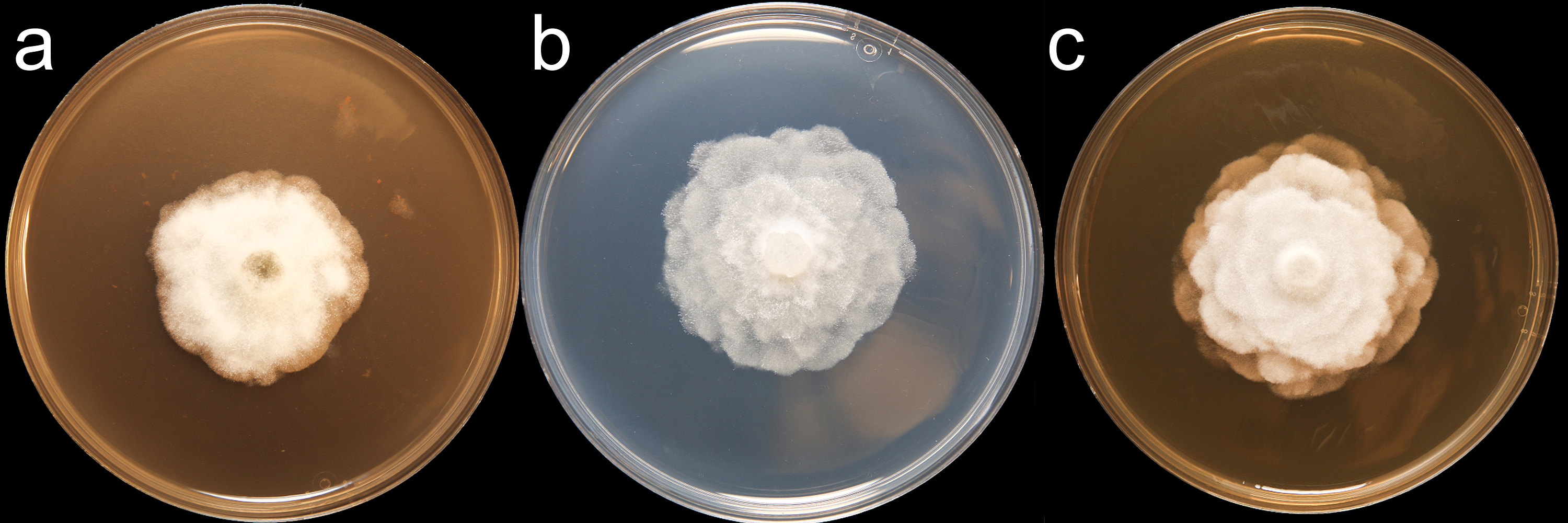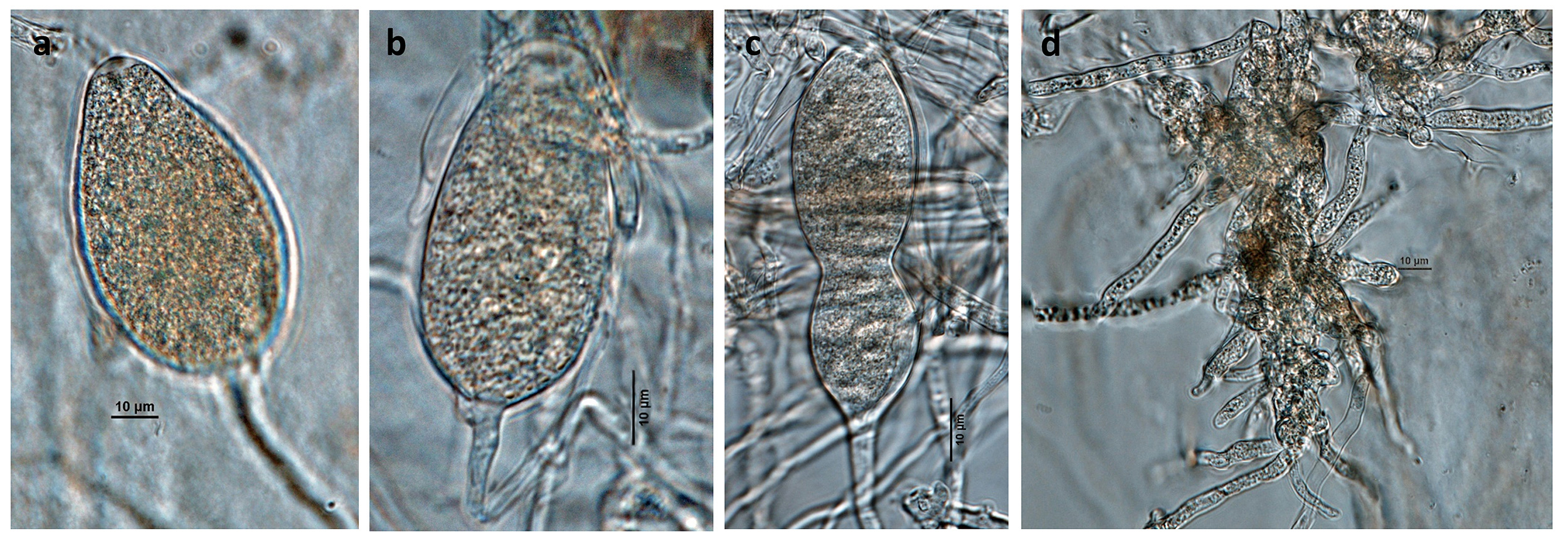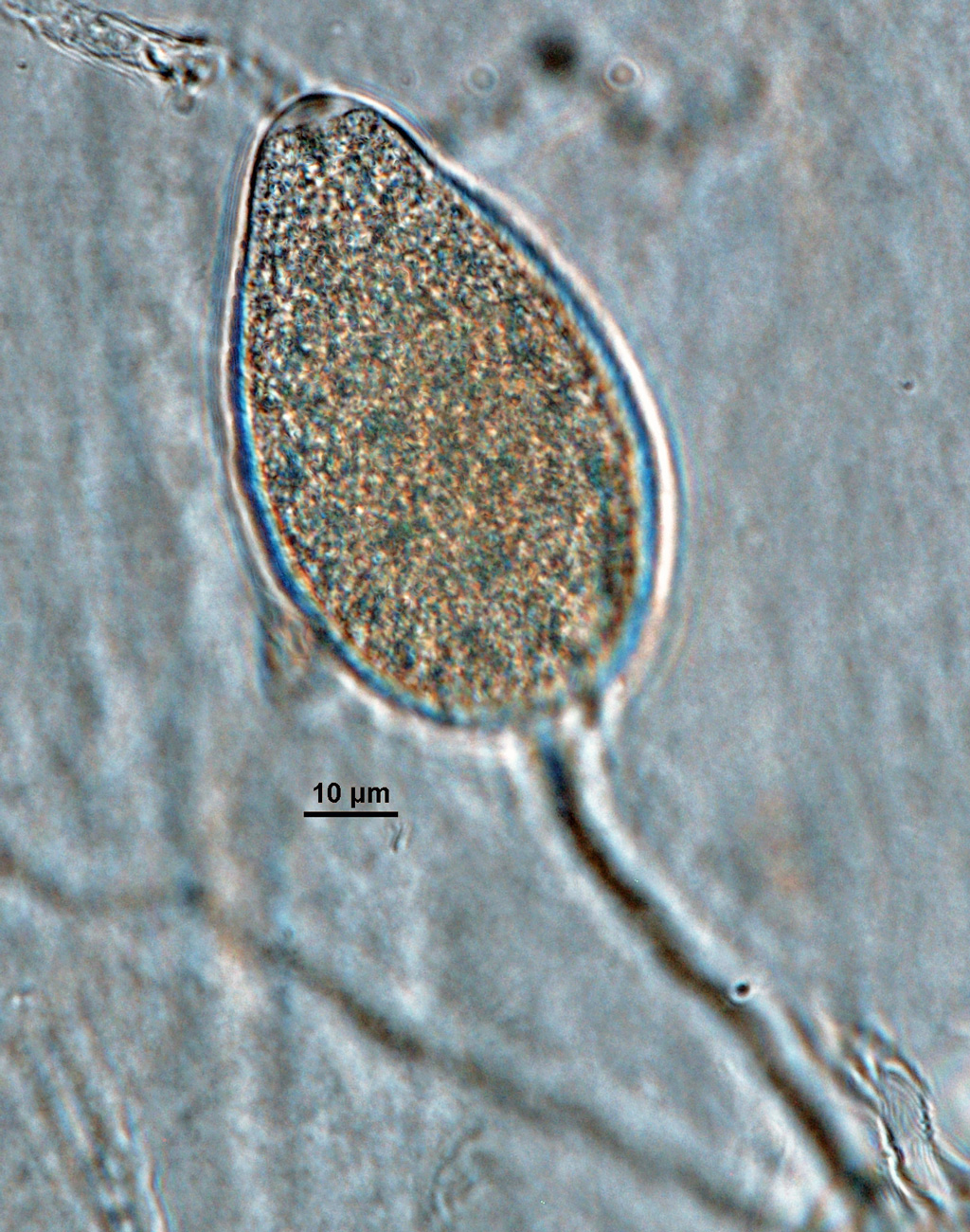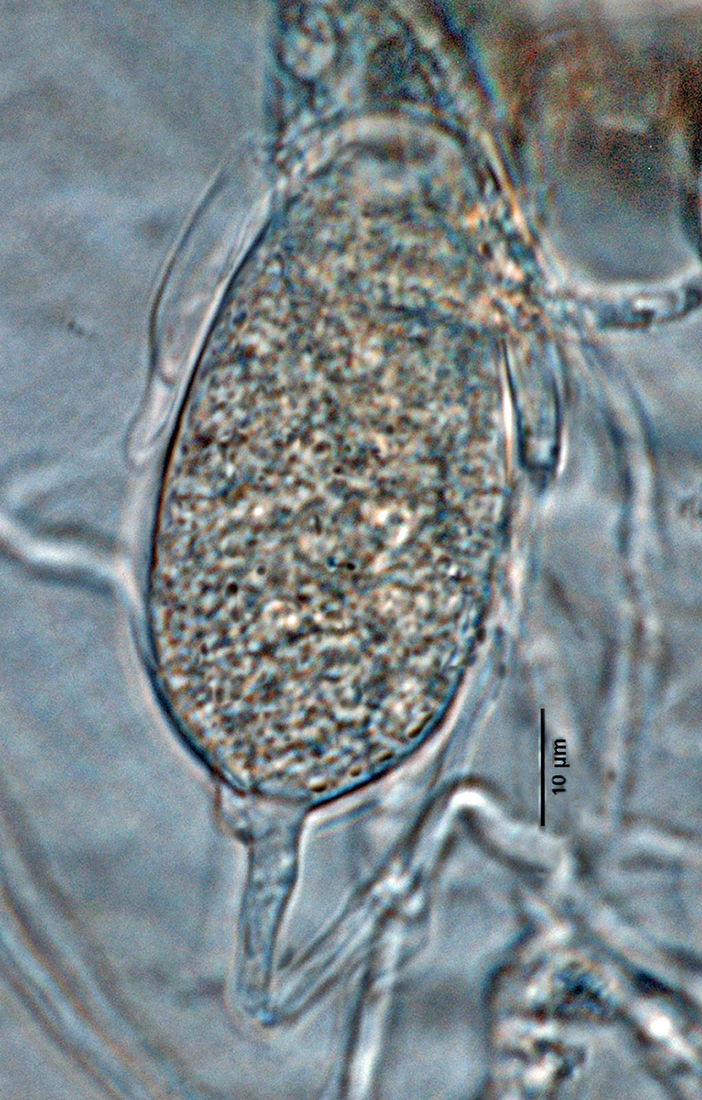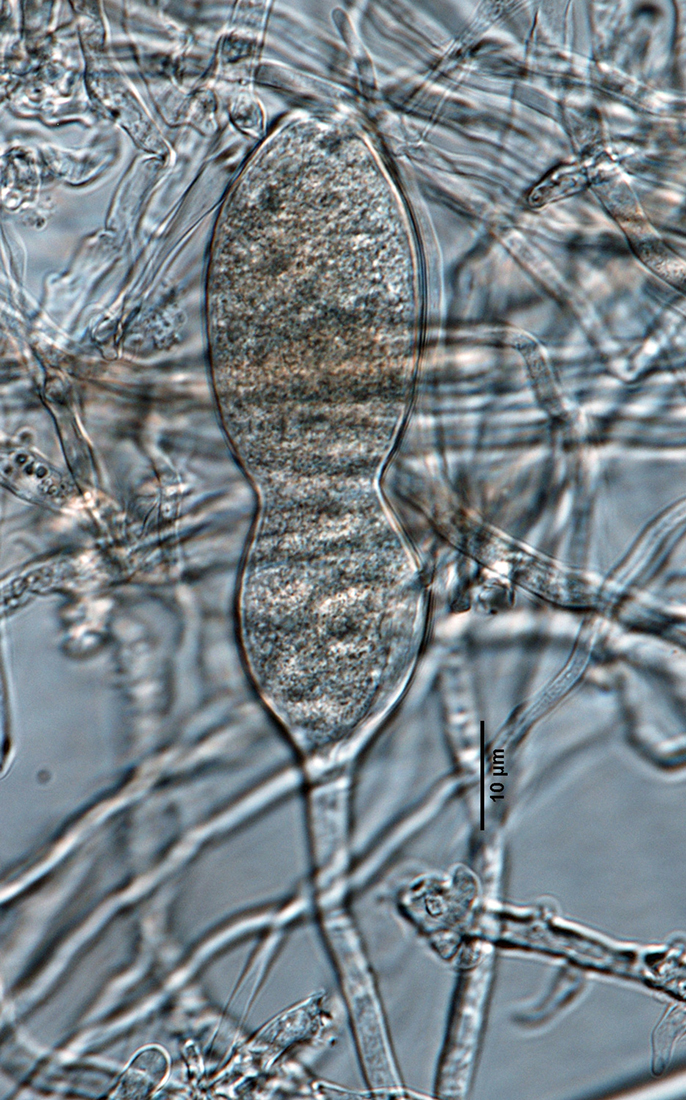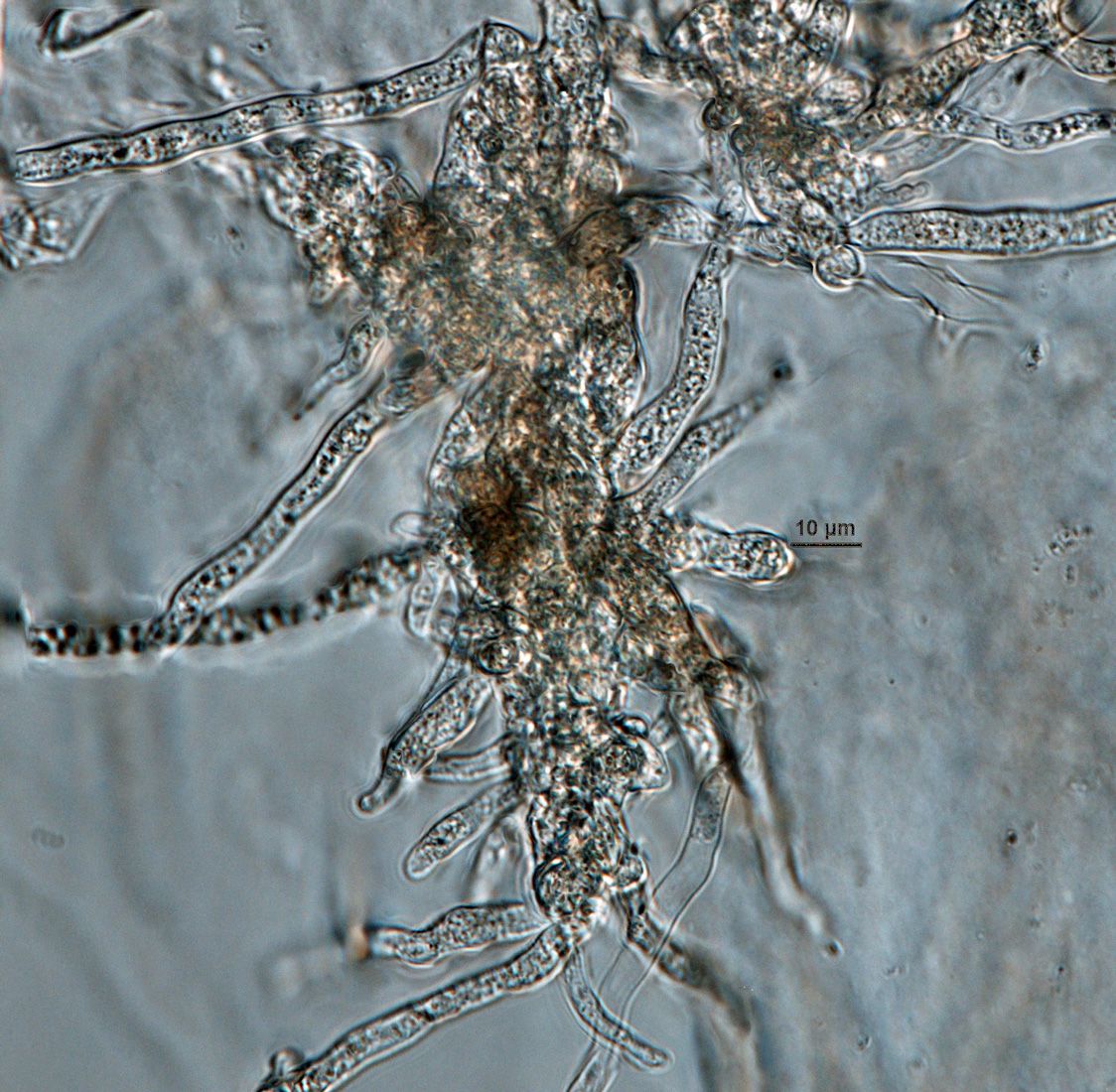Phytophthora gonapodyides (in progress - Abad et al. 2023b)
|
Phytophthora spp. in subclade 6b: portion of the seven-loci ML phylogeny featuring the type cultures of 212 described species (by T. Bourret). Notice the position of P. gonapodyides selected specimen CBS 554.67 = S&T BL 214. Gloria Abad, USDA S&T.
|
|
Phytophthora spp. in subclade 6b: Morphological Tabular key (PDF) and Tabular key legends (PDF) in IDphy2 KEY SECTION. Notice the data of P. gonapodyides selected specimen CBS 554.67 = S&T BL 214. Gloria Abad, USDA S&T.
|
|
Phytophthora gonapoidyides (CPHST BL 172) colonies of a selected specimen grown for 7 days on (a) V8® Agar, (b) potato dextrose agar, and (c) malt extract agar; photo by Krysta Jennings and Leandra Knight, USDA-APHIS-PPQ. |
|
Phytophthora gonapodyides (CPHST BL 172, selected specimen) asexual phase: (a–c) nonpapillated sporangia produced in unbranched sporangiophores; (d) radiating hyphae; photos by Gloria Abad, USDA-APHIS-PPQ. |
|
Phytophthora gonapodyides (CPHST BL 172, selected specimen) asexual phase: nonpapillated sporangium produced in unbranched sporangiophore; photo by Gloria Abad, USDA-APHIS-PPQ. |
|
Phytophthora gonapodyides (CPHST BL 172, selected specimen) asexual phase: nonpapillated sporangium produced in unbranched sporangiophore; photo by Gloria Abad, USDA-APHIS-PPQ. |
|
Phytophthora gonapodyides (CPHST BL 172, selected specimen) asexual phase: nonpapillated sporangium produced in unbranched sporangiophore; photo by Gloria Abad, USDA-APHIS-PPQ. |
|
Phytophthora gonapodyides (CPHST BL 172, selected specimen) asexual phase: radiating hyphae; photo by Gloria Abad, USDA-APHIS-PPQ. |
Name and publication
Phytophthora gonapodyides (H. E. Petersen) Buisman (1927)
Buisman, C. J. 1927. Root rots caused by Phycomycetes. Mededelingen uit het Phytopathologisch laboratorium ‘Willie Commelin Scholten’ 11: 1–65.
Nomenclature
Mycobank
Synonymy
≡ Pythiomorpha gonapodyides H.E. Petersen, Botanisk Tidsskrift 29: 391 (1909) [MB162746]
≡ Pythiomorpha gonapodyoides H.E. Petersen (1909) [MB528833]
Typification
from Buisman (1927)
Type: UNITED KINGDOM, in fallen submerged fruits of Pyrus malus and fallen branches of Alnus sp. (debris)
Ex-type: LOST
Well-authenticated specimen(s) selected by Gloria Abad:
- Selected specimen #1: CPHST BL 66 = P7050 (WPC) from vegetable debris, UNITED KINGDOM
- Selected specimen #2: CPHST BL 172 = P6992 (WPC) from soil, UNITED STATES OF AMERICA
Selected specimen(s) in other collections
(SE) CBS 554.67, NRRL 64034, ATCC 60351 (MCI), S&T BL 214 (Abad), No 451a, 34A8 (Hong)
Molecular identification
Voucher sequences for barcoding genes (ITS rDNA and COI) of the selected specimen (see Molecular protocols page)
Phytophthora gonapodyides isolate CPHST BL 66 (= P7050 WPC) = ITS rDNA MG865501, COI MH136896
Phytophthora gonapodyides isolate CPHST BL 172 (= P6992 WPC) = ITS rDNA MG865502, COI MH136897
Voucher sequences for Molecular Toolbox with seven genes (ITS, β-tub, COI, EF1α, HSP90, L10, and YPT1
(see Molecular protocols page) (In Progress)
Voucher sequences for Metabarcoding High-throughput Sequencing (HTS) Technologies [Molecular Operational Taxonomic Unit (MOTU)]
(see Molecular protocols page) (In Progress)
Sequences with multiple genes for selected specimen in other sources
- NCBI: Phytophthora gonapodyides CPHST BL 66
- NCBI: Phytophthora gonapodyides CPHST BL 172
- NCBI: Phytophthora gonapodyides P7050
- EPPO-Q-bank: Phytophthora gonapodyides
- BOLDSYSTEMS: Phytophthora gonapodyides (barcoding COI & ITS)
Position in multigenic phylogeny with 7 genes (ITS, β-tub, COI, EF1α, HSP90, L10, and YPT1)
Clade clade:
a taxonomic group of organisms classified together on the basis of homologous features traced to a common ancestor
6b
Morphological identification
Colonies and cardinal temperatures
Colony colony:
assemblage of hyphae which usually develops form a single source and grows in a coordinated way
morphology after 7 days on PDA, V-8, and MEA with rosette pattern. Minimum growth temperature 3°C, optimum 24–27°C, and maximum 30°C.
Conditions for growth and sporulation
Sporangia and hyphal swellings are produced under water cultures.
Asexual phase
SporangiaSporangia:
sac within which zoospores form, especially when water is cooled to about 10°C below ambient temperature; in solid substrates, sporangia usually germinate by germ tubes
nonpapillatenonpapillate:
pertaining to the production of a non-distinct, or inconspicuous, papilla at the distal end of the sporangium (cf. papillate and semipapillate)
; persistentpersistent:
pertaining to sporangia that remain attached to the sporangiophore and do not separate or detach easily (cf. caducous)
; ellipsoidellipsoid:
refers to a solid body that forms an ellipse in the longitudinal plane and a circle in cross section; many fungal spores are ellipsoidal or elliptic
, ovoidovoid:
egg-shaped, with the widest part at the base of the sporangium and the narrow part at the apex
or distorted shapes with tapered basetapered base:
pertaining to the base of a sporangium or oogonium; funnel-shaped
(36–71 L x 21–32 W µm) showing internal extended and nested proliferationnested proliferation:
a type of internal proliferation where a new sporangium develops successively inside the old sporangium after it has emptied
and produced in unbranched sporangiophores. Hyphal swellings globoseglobose:
having a rounded form resembling that of a sphere
, subglobose, and elongate produced solitary or catenulatecatenulate:
having a chain-like form
in chains. ChlamydosporesChlamydospores:
an asexual spore with a thickened inner wall that is delimited from the mycelium by a septum; may be terminal or intercalary, and survives for long periods in soil
absent.
Sexual phase
Sterile.
Most typical characters
Phytophthora gonapodyides is characterized by the presence of sporangiasporangia:
sac within which zoospores form, especially when water is cooled to about 10°C below ambient temperature; in solid substrates, sporangia usually germinate by germ tubes
showing internal nested proliferationnested proliferation:
a type of internal proliferation where a new sporangium develops successively inside the old sporangium after it has emptied
and hyphal swellings.
Specimen(s) evaluated
Phytophthora gonapodyides CPHST BL 66, duplicate of P7050 (World Phytophthora Collection)
Hosts and distribution
Distribution: North America (USA), Europe (Denmark, Hungary, Italy, Sweden, Turkey); also reported from Australia, New Zealand, and South America (Chile)
Substrate: roots, seedlings
Disease note: root rot; a minor pathogen
Host: 13 genera in 11 families, including Malus spp. (Rosaceae); possibly also on Pinaceae seedlings including Pseudotsuga menziesii (Douglas fir), Abies spp., and Tsuga mertensiana (mountain hemlock)
Retrieved January 30, 2018 from U.S. National Fungus Collections Nomenclature Database.
Additional info: saprophyte
Additional references and links
- SMML USDA-ARS: Phytophthora gonapodyides
- EPPO Global Database: Phytophthora gonapodyides
- Forest Phytophthoras of the world: Phytophthora gonapodyides
- CABI Digital Library: Phytophthora gonapodyides
- Encyclopedia of Life (EOL): Phytophthora gonapodyides
- Index Fungorum (IF): Phytophthora gonapodyides
- Google All Phytophthora gonapodyides
- Google Images Phytophthora gonapodyides
- Google Scholar Phytophthora gonapodyides
Fact sheet author
Z. Gloria Abad, Ph.D., USDA-APHIS-PPQ-S&T Plant Pathogen Confirmatory Diagnostics Laboratory (PPCDL), United States of America.

